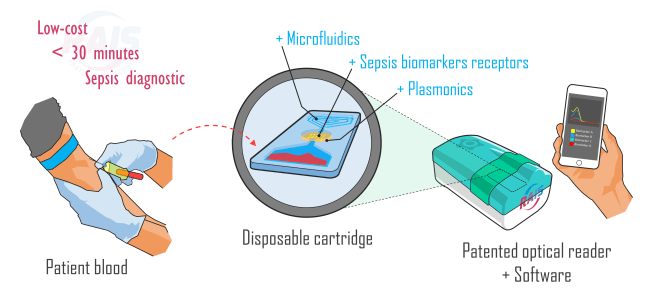Sepsis, a deadly reaction to infection, is thought to kill more than 20,000 people a day worldwide. Whilst rapid detection of the condition is critical to effective treatment, current detection techniques can take hours or even days to produce a diagnosis.

The new system, developed by the EU-funded RAIS consortium, which includes researchers from Spain, Switzerland, Germany, Belgium, the UK and Italy uses light to look for specific biomarkers that are as small as few nanometres in size, or 1/1,000,000th of the thickness of a single human hair.
During operation, a small blood sample is taken from a patient’s thumb or forefinger and is separated in a centrifuge so that a clinician can examine the plasma, the part of the blood sample where all the proteins are contained.
The plasma sample flows over a microarray, a collection of tiny spots containing specific antibodies on a nanostructured gold slide. Two light beams are then shone through the full microarray, with one of them passing through the sample, while the other one goes through the clear part of the slide, acting as a ‘reference’.
The beams passing through the biomarker and the clear regions on the slide are then checked for any changes in intensity.
“Depending on the amount and type of biomarker attached to each antibody, we obtain a unique image: a signature pattern if you like. The image patterns tell us what is present in the plasma sample, which we then record with a CMOS sensor, the same technology used in a digital camera that converts light into electrons,” said Project coordinator, Dr Roland Terborg from Barcelona’s Institute of Photonic Sciences (ICFO)
“The low-cost point-of-care microarray platform will allow clinicians to identify sepsis early and therefore start patients on the right treatment quickly, potentially reducing the mortality rate by as much as 70-80 per cent. The detector will have a significant impact on European industry, making it more competitive in the point-of-care medical market for detection of sepsis and other infectious diseases,” Dr Terborg said.
Pre-clinical trials have already begun at the Vall d'Hebron University Hospital in Barcelona where the device has been in operation since 2018. Clinical trials are expected to take place at the end of 2019.
The researchers claim that the device could also be extended to carry out other types of disease screening or multiple simultaneous diagnoses, especially those requiring a rapid detection of large numbers of biochemical targets on a single microarray.





Poll: Should the UK’s railways be renationalised?
The term innovation is bandied about in relation to rail almost as a mantra. Everything has to be innovative. There is precious little evidence of...